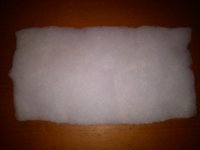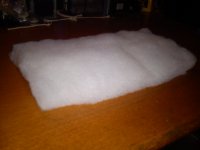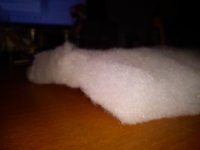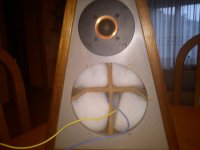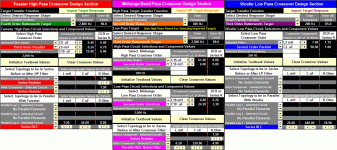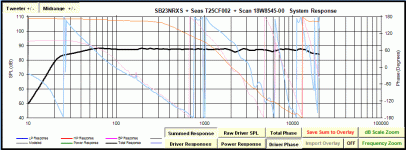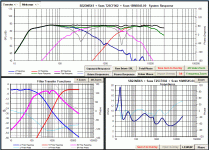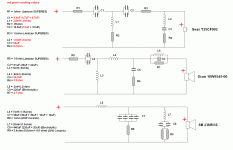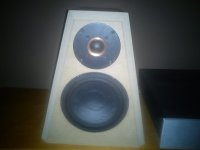For the bottom cab, I would try it first without the bitumen. 25-30mm of foam on the walls (you could try it with or without felt) should probably work fine.
Do you refer to bass cab?
I have polyester fiber 30mm, could I use 3 or 4 layers to cover all the back side of the mid-higs cabs? Also could I use only 1 layer 3cm for top, bottom and both lateral sides of the mid-highs cabs? If yes to both questions could return the 1cm foam.
BTW I used the top cabs without bitumen & without the foam only with polyester fiber with good results....
I guess the two bitumen layers are for all sides of mid-highs cabs except for the front, right?
BTW I used the top cabs without bitumen & without the foam only with polyester fiber with good results....
I guess the two bitumen layers are for all sides of mid-highs cabs except for the front, right?
Attachments
Last edited:
Do you refer to bass cab?
Yes
I have polyester fiber 30mm, could I use 3 or 4 layers to cover all the back side of the mid-higs cabs? Also could I use only 1 layer 3cm for top, bottom and both lateral sides of the mid-highs cabs? If yes to both questions could return the 1cm foam.
BTW I used the top cabs without bitumen & without the foam only with polyester fiber with good results....
I guess the two bitumen layers are for all sides of mid-highs cabs except for the front, right?
These are your speakers so whatever makes your ears and budget happy is what you should do. If you like the top cab the way it is, then don't change anything. Leave it as is.
If you want to see if you can improve it then replace the polyester with higher density (and higher sound absorbing) foam or fiberglass. If you enjoy experimenting and critical listening then try the bitumen (yes, excluding the baffle, but you could try it there too) with the polyester. Then remove the polyester and try the bitumen with slowly increasing increments of foam. If you think the new sound is worse than the previous one then go back one step and stop there. You could even try the amount of foam I've suggested with a little bit of polyester behind the driver.
Whatever sounds best to you.
You should actually give something like this a try. It'll be good practice because the xo I give you will be for a simulation and it's doubtful that everything will match up absolutely perfectly in the real world. Hopefully very close, but not perfect. You're going to have to listen, identify what doesn't sound right to you and then we can make adjustments until you have a very big smile on your face.
I was going to wait until you had your next cabinet ready before posting a new xo but some of the parts I was looking at for you are going to take up to a couple of weeks to get in so I thought you might want to get the order in sooner rather than later.
I changed the tweeter high pass to 3rd order and got an improved phase alignment so that the listening position is directly on-axis. Much better (although the mid/tweeter phase still isn't perfect but soemtimes you just have to go with good enough). The rest of the xo's are all 2nd order. All drivers are connected with positive polarity. Sensitivity is about 87dB with a variation of about +1dB and -1.5dB from 40Hz to 10,00Hz. F3 is about 30Hz. Crossover points are at about 290Hz and 2200Hz.
The xo is modeled with about 3dB of baffle step loss and this is the tricky part. Ideally you would measure the drivers' responses once you get the cabinets built and the drivers mounted and then design the xo but we're out of luck with that in this situation. So I'm guesstimating. In an anechoic environment, the baffle step loss is 6dB but typically with 3-way floor standing speakers in a real room, it will be less than that. So I'm going to start off in the middle with 3dB loss and then we can adjust from there. This will be the 1st thing that you will have to do once the xo is put together - adjust the levels of the mid and tweeter so that the bass matches to your liking in your room. Keep your fingers crossed that -3dB will do the trick. Get some alligator clips if you don't already have some because there are certain parts that you won't want to solder together at first until you have finished voicing the speaker. I hope you like tweaking..... 😀
I've tried to use as many of the parts that you already have. Sorry I couldn't use them all. Make sure I have them right especially the resistance values for the inductors. I'm not sure that the LCR impedance flattening filter on the tweeter is absolutely necessary (L2-C3-R4), but it doesn't hurt (and may help) so, since you already have the parts, I've included it. I've kept the cost of the new parts as low as I could but it's still going to cost you a bit. If you want to go to higher end caps or inductors, let me know and I can tell you which ones will have the greatest effect (possibly).
Double check I've got everything right before ordering. In the parts list you'll notice some extra resistors. These are included for any possible adjustments you might have to make.
Charts below:
1 - Frequency response (black) with power response (green), reverse nulls (grey), individual driver responses, transfer functions, overall impedance and impedance phase angle.
2 - Frequency response with driver phase alignment.
3 - PCD xo details
4 - xo diagram
5 - Parts list from Europe Audio
I changed the tweeter high pass to 3rd order and got an improved phase alignment so that the listening position is directly on-axis. Much better (although the mid/tweeter phase still isn't perfect but soemtimes you just have to go with good enough). The rest of the xo's are all 2nd order. All drivers are connected with positive polarity. Sensitivity is about 87dB with a variation of about +1dB and -1.5dB from 40Hz to 10,00Hz. F3 is about 30Hz. Crossover points are at about 290Hz and 2200Hz.
The xo is modeled with about 3dB of baffle step loss and this is the tricky part. Ideally you would measure the drivers' responses once you get the cabinets built and the drivers mounted and then design the xo but we're out of luck with that in this situation. So I'm guesstimating. In an anechoic environment, the baffle step loss is 6dB but typically with 3-way floor standing speakers in a real room, it will be less than that. So I'm going to start off in the middle with 3dB loss and then we can adjust from there. This will be the 1st thing that you will have to do once the xo is put together - adjust the levels of the mid and tweeter so that the bass matches to your liking in your room. Keep your fingers crossed that -3dB will do the trick. Get some alligator clips if you don't already have some because there are certain parts that you won't want to solder together at first until you have finished voicing the speaker. I hope you like tweaking..... 😀
I've tried to use as many of the parts that you already have. Sorry I couldn't use them all. Make sure I have them right especially the resistance values for the inductors. I'm not sure that the LCR impedance flattening filter on the tweeter is absolutely necessary (L2-C3-R4), but it doesn't hurt (and may help) so, since you already have the parts, I've included it. I've kept the cost of the new parts as low as I could but it's still going to cost you a bit. If you want to go to higher end caps or inductors, let me know and I can tell you which ones will have the greatest effect (possibly).
Double check I've got everything right before ordering. In the parts list you'll notice some extra resistors. These are included for any possible adjustments you might have to make.
Charts below:
1 - Frequency response (black) with power response (green), reverse nulls (grey), individual driver responses, transfer functions, overall impedance and impedance phase angle.
2 - Frequency response with driver phase alignment.
3 - PCD xo details
4 - xo diagram
5 - Parts list from Europe Audio
Attachments
Last edited:
Thanks for the simulation, I will try to take some measurements before to buy the xo components I wanna be sure because cost a lot of money.
Well, if you can get measurements done then that should help. But hopefully that won't cost you even more money.........
I have one Behringer ECM8000 as micro, soundcard USB M-Audio Audiophile 24/96 and REW as software, it's enough?
All drivers are connected with positive polarity.
I'm not sure about that. The polarity of the woofer should be reversed IMO.
I have one Behringer ECM8000 as micro, soundcard USB M-Audio Audiophile 24/96 and REW as software, it's enough?
Sorry, I am not that knowledgeable about measurement systems and methodology yet. Someone else will have to help you with that.
I'm not sure about that. The polarity of the woofer should be reversed IMO.
Well, PCD doesn't lie. The 1st reverse null clearly shows what happens when the polarity between the mid and woofer are reversed. I don't think that response is desirable.
Time has passed. I have cut the frontal of corian and have lined the box of bitumen of 2mm and foam of 1cm (I raise a photo of the work), the another box already has the altar frontal stuck and I am waiting that frague 24 hours that prompt with your help pus to start doing measures🙂

I'm not sure about that. The polarity of the woofer should be reversed IMO.
Dissi, I just went over my simulation to refresh my memory and it turns out you were absolutely correct. My apologies. 😱
My sim was correct but I failed to transcribe it correctly. I had the tweeter and mid polarity reversed but I read them as the other way around. So reversed polarity on the woofer will achieve the same thing. Good catch.
- Status
- Not open for further replies.
- Home
- Loudspeakers
- Multi-Way
- Help for 3 or 4 way loudspeaker
